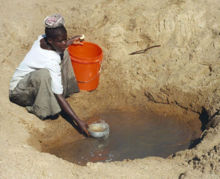|
|
| Line 20: |
Line 20: |
| | | | |
| | === Causes === | | === Causes === |
| − | *Lack of appropriate technology | + | *Lack of appropriate technology. Technology, when invented, is not spread for the good of mankind, but kept artificially scarce by patents, corporate secrecy, limited runs and planned obsolescence. This is motivated by the monetary sytem. The post-scarcity solution is to post designs of machines publicly on the Internet so that anyone with access to [[Virtual designs into physical objects/Fab Labs|fabrication equipment]] can make them from raw materials. |
| | *Locked-up resources | | *Locked-up resources |
| | *Short-term thinking | | *Short-term thinking |
| − | *Inadequate co-operation (lack of communication and sharing of knowledge) | + | *Inadequate co-operation (lack of communication and sharing of knowledge). This is also largely motivated by the monetary system, with different researchers from different company competing and guarding their knowledge, rather than working together for the good of mankind. |
| | *Self-interest (at many levels) | | *Self-interest (at many levels) |
| − | *Cultural inertia (that's the way it has always been done) | + | *Cultural inertia (that's the way it has always been done). |
| | *Lack of trust | | *Lack of trust |
| | *Ignorance (lack of education or understanding) | | *Ignorance (lack of education or understanding) |
Revision as of 04:30, 27 April 2010
So what surmountable scarcity exists today?
 Slums built on swamp land near a garbage dump in Jakarta  Collecting water in Mwamanongu Village, Tanzania  Pharmaceuticals, which are kept artificially scarce by commercial pricing All the usual suspects, and a lot applies as much to Western countries as it does to the developing world.
- Clean energy
- Clean water
- Nutritious food
- Medicine and medical facilities
- Decent housing in slum areas
- Sustainable development

- High quality, interesting education
- Safe and efficient transport that doesn't kill or maim significant numbers of passengers or contribute to changing our climate
- The facilities for people and communities to do more things for themselves - we are too reliant on machines and products from big business. Most people are not in a situation where they can even keep themselves alive when cut off from the products of centralized production, and this leads to unnecessary deaths and suffering when these services are disrupted in disasters
- Resources to get things done that need to be done - at a community level — sounds woolly perhaps but covers uncountable worthy projects that simply don't get done through lack of funds, manpower or bureaucratic hurdles
- Quality - quality products and architecture as examples.
- Time - people's time. Time to follow things important to the individual. Time for other people.
Causes
- Lack of appropriate technology. Technology, when invented, is not spread for the good of mankind, but kept artificially scarce by patents, corporate secrecy, limited runs and planned obsolescence. This is motivated by the monetary sytem. The post-scarcity solution is to post designs of machines publicly on the Internet so that anyone with access to fabrication equipment can make them from raw materials.
- Locked-up resources
- Short-term thinking
- Inadequate co-operation (lack of communication and sharing of knowledge). This is also largely motivated by the monetary system, with different researchers from different company competing and guarding their knowledge, rather than working together for the good of mankind.
- Self-interest (at many levels)
- Cultural inertia (that's the way it has always been done).
- Lack of trust
- Ignorance (lack of education or understanding)
- Incompetent government administration
- Bureaucracy
- War
- and in no small part, monetary economics. Under monetary economics, when a technology is invented that could — for example — help bring clean water to everyone on Earth, instead of being instantly brought to bear on making the world work better for humanity, it must go through a process in which patents are approved, business plans are written, market research is conducted, feasibility studies carried out, investment raised, contracts negotiated and so on. This creates a delay of several years before a solution can be put in practice. In a situation of decentralized fabrication and free and open-source design, once a design is posted on the Internet, it can be reproduced around the world by anyone who needs it. The time from invention to implementation can be shorten from years to hours. In a period of history when new inventions spring up so rapidly, rapid implementation is more vital than ever.
See also
|
|
 previous page | next page
previous page | next page 



